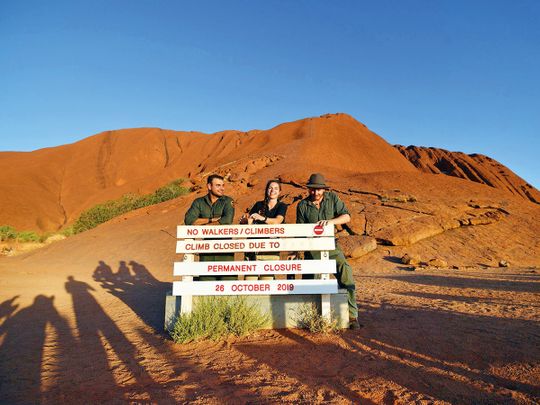
ULURU, Australia: Australia’s Uluru was permanently closed to climbers on Friday evening to meet the wishes of Aboriginal people who hold the red monolith sacred, but hundreds of tourists scaled it in the final hours before the ban.
With the last-ever climbers due back by sunset, rangers shut the entry gates to the world-famous site also known as Ayers Rock.
The ban, first announced in 2017, had long been sought by the traditional Aboriginal owners of the land, the Anangu, whose connection to the site dates back tens of thousands of years.
There were already signs at the base of the rock imploring visitors not to climb it, but these were not often heeded, especially in recent months as a surge of tourists made last-minute ascents.
“I came here just to see it but it is the last day possible (to climb Uluru), so I have decided to try it,” Polish tourist Matt Oswiecimiki told AFP.
The 29-year-old said it was “fair to stop it” tomorrow out of respect for the Anangu, but said the one-time opportunity meant he would still climb it given he was allowed to on Friday.
Tourists are still being encouraged to visit the Uluru-Kata Tjuta National Park where they can take in the monolith from its base, walk around its perimeter and learn about its indigenous heritage at the cultural centre.
“It’s enough for me to walk around and see the rock,” Japanese tourist Masahira Suda said.
The 25-year-old said he did not judge fellow tourists for scaling Uluru but he was refraining at the request of the Aboriginal custodians.
“I really have respect for them,” he said.
Spiritual significance
More than 395,000 people visited the park in the 12 months to June 2019, according to Parks Australia — about 20 per cent more than the previous year.
Around 13 per cent of those who visited during that period made the climb, park authorities said.
Uluru has great spiritual and cultural significance to indigenous Australians, and the Anangu people will hold a ceremony Saturday to mark the climbing ban.
Indigenous Affairs Minister Ken Wyatt likened the recent increase in tourists climbing Uluru to “a rush of people wanting to climb over the Australian War Memorial”.
“Our sacred objects, community by community, are absolutely important in the story and the history of that nation of people,” he told national broadcaster ABC.
Traditional owners have long encouraged people to refrain from climbing the site for its cultural significance, to protect it from further environmental damage and to ensure visitors’ safety.
Tackling Uluru’s sandstone slopes has not been an easy exercise, and at least 35 people have died attempting the climb.
It towers some 348 meters (1,148 feet) and summer temperatures often hit 45 degrees Celsius (113 Fahrenheit).
Saturday marks 34 years since that the park’s title was handed back to the traditional owners.
Australia’s Uluru joins other cultural sites in fight for survival
Below is a list of cultural and other important sites that have closed or imposed new restrictions on tourists as authorities grapple with the challenge of how best to protect people, heritage, the environment and wildlife.
1. MAYA BAY, THAILAND: The island cove was made famous by the 2000 film “The Beach” starring Leonardo DiCaprio. It was closed to tourists last year until 2021 in a bid to salvage the area’s coral reefs, which have been damaged by warmer temperatures and a flood of tourists.
2. BORACAY ISLAND, THE PHILIPPINES: The resort was closed for a six-month cleanup from April to October 2018 after being described as a “cesspool” by President Rodrigo Duterte. The island attracted 2 million visitors the previous year but has now limited numbers to 19,000 per day and banned beach parties, smoking and drinking.
3. MOUNT EVEREST BASE CAMP, CHINA: The Chinese government closed its side of the Everest base camp this year to anyone without a climbing permit due to the huge amounts of rubbish piling up at the site, according to the Lonely Planet travel website. The Chinese base camp, located in Tibet, was accessible by car.
4. FJADRARGLJUFUR CANYON, ICELAND: The popular site, which featured in one of Justin Bieber’s music videos, was closed to tourists for about three months this year due to damage from wet weather and foot traffic. The number of visitors had nearly doubled after being featured in the pop singer’s “I’ll Show You” video.
5. THE FAROE ISLANDS, DENMARK: Ten popular tourists sites were closed temporarily this year for maintenance by an international team of volunteers after a 10% growth in visitor numbers in recent years.
6. SIPADAN ISLAND, MALAYSIA: One of the world’s most renowned scuba diving spots on Malaysia’s part of Borneo island will be shut for a month every December from 2020 to allow the coral and marine ecosystem to recuperate.
7. KOMODO ISLAND, INDONESIA: Authorities are due to limit visitor numbers and raise entry prices to the island in order to conserve the population of the Komodo dragons, the world’s largest living species of lizard. Officials initially planned to close the island for one year from 2020 but later scrapped the idea.
8. SPANISH STEPS, ITALY: Rome banned tourists from sitting on the famous monument in August, in a crackdown on overcrowding by tourists. Visitors can still walk up and down, but offenders of the sitting ban can be fined up to €400 ($444, Dh1,629).
The site was largely shut between October 2015 and September 2016 for a private restoration after the 135 steps had become loose, stained and cracked under the strain of daily use by both residents and visitors.












